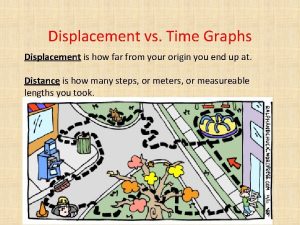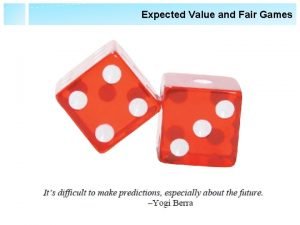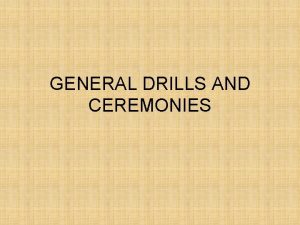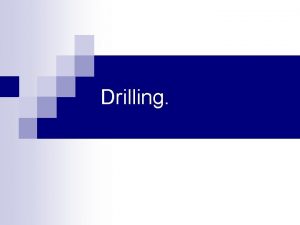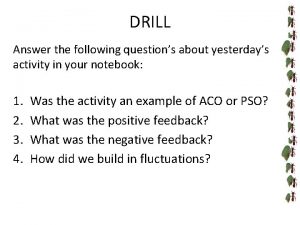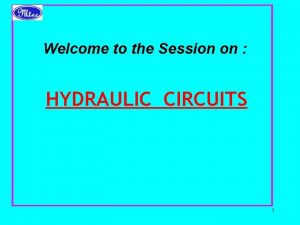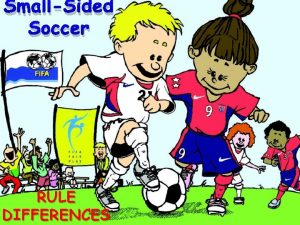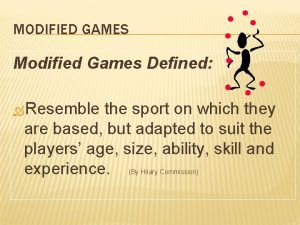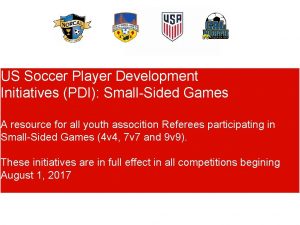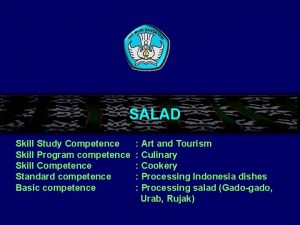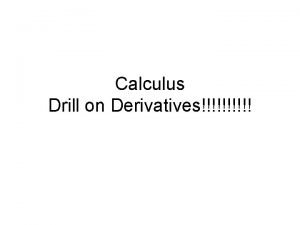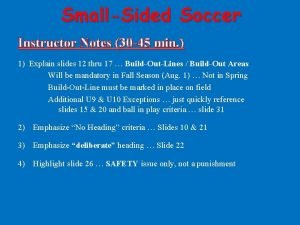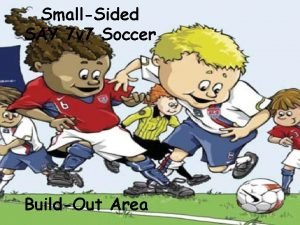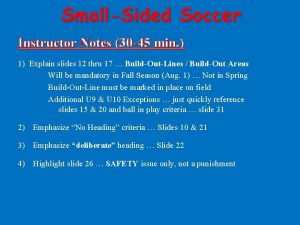SKILL TRAINING Drill practice Modified and smallsided games













- Slides: 13

SKILL TRAINING • Drill practice • Modified and small-sided games • Games for specific outcomes (eg decision-making, tactical awareness)

Skill Training Skill training is new content not addressed at all in Factors Affecting Performance. However, practice methods, feedback, and performance elements are all important background knowledge (you may also want to check out design a suitable plan for teaching beginners to acquire a skill through to mastery). This training method focuses on the development of skills specific to the athlete’s sport. Skills are developed through the stages of skill acquisition using a number of different training methods that are made specific for each sport. Training methods include: drills (massed, distributed, etc practice methods), modified and small-sided games (2 on 2 basketball, half field etc), and games for specific outcomes (decision making, tactical awareness).

Skill training programs are often varied and have many different segments to them. Often skill training is done using methods that replicate the specific sport. This means tennis is done individually on court, while football is done as a team on the field. However, this is not always the case. There are plenty of people who develop skills in 1 -on-1 skill training sessions. Skill training needs to be individualised in order to ensure improvements in performance. Skill training methods should match the players skill level and stage of skill acquisition, along with being age appropriate and further developing the skills needed in the sport.

Skill training focuses on technique of the skill and ways of applying the skill in competition. Together the aim is to improve performance through more consistent skill execution and better choice of skill application in competition. A skill training program will have various different activities done in sequence focusing on particular skills. For example, after warming-up the athlete may complete 10 min of passing drills, before competing in a modified game that seeks to further develop passing skills such as 1 touch or 2 seconds with the ball. After this further drills on set plays may follow, that focus on decision making around the type of pass used (long, short, cut-out, lob, bounce etc). All skill training sessions should finish with a cool-down and session review. This training is used to develop skills in the following ways: • improve fundamental movements required in the sport • individual developmental needs • understanding the sport • decision making • communication • performance under pressure

Measuring skill training adaptations Adaptations in skill are specific to the skill and require specific testing. Statistical analysis is often used to provide feedback on skill adaptations. If a player improves their goal shooting percentage, completed passed, or backhand winners then this indicates an improvement in the skill. Other measurements such as biomechanics analysis can be used to measure improvements in biomechanical efficiency of movement for example in running, tennis serve or bowling in cricket. The most often used measures are feedback of results and aesthetics of skill execution.

Safety in skill training There a variety of safety aspects for training, the most fundamental safety aspect is an adequate warm-up. Other aspects of the athlete’s level of physical preparation (skill and technique, physical fitness etc) are also important for safety in skill training. Drills Practice Drills practice is the fundamental core of all skill training. Each sport has its own set of drills for developing the skills required. Drills essentially provide the frequent repetition of a skill that is required for the athlete to progress through the stages of skill acquisition towards autonomous skill mastery. Key aspects of drills practice include: frequent repetition of the skill, fast and effective feedback, and adjustment of skill execution. Drills can be completed as part of a team or in 1 -on-1 training sessions. The choice of drill should suit the individual athlete in relation to their stage of still acquisition and their sport. There should be a variety of drills used in the training session and across the training program to ensure the athlete does not get bored, and learn to use the skill in a variety of contexts

In team sports, drills are often done as part of a whole team training session. During these larger team sessions usually follow the following pattern: • Session outline • warm-up • conditioning • skills/drills • modified game • full game/tactical application • cool-down • session review These types of training sessions often go for long periods of time and are often not specific to individual athletes. Within training sessions drills practice can be massed, distributed, part or whole as a practice method. The practice method chosen should suit the athlete, skill and sport. Generally skills are best learnt with short frequent drill sessions. That is, 30 -45 minutes of practice 3 -5 days a week, rather than 2 -3 hours 1 -2 days a week.

Modified and small-sided games Drill practice is not enough on its own for improved performance, modified and small -sided games help to ensure improvements in skill execution transfer into games/competition. A modified game replicates the sport, but changes some of the rules. Examples of rules changed include: limited touches or time with the ball, smaller field/court size, different sized balls or goals, or the added requirement to defend repeatedly. Modified games allow for greater focus on specific skills, with the changes in rules aiming to increase the need for a particular skill. For example, when looking to improve basketball jump shots, the modified game could make jump-shots worth 4 points, or the only way to score in order to increase the number of jump-shots taken. Small-sided games also increase the opportunity for skill execution, but do so by increasing each player’s time and repetition of the skill. For example, a 2 -on-2 football game inside the 18 yard box, increases the athletes time on the ball, and will increase the number of passes needing to be complete, as well as movement off the ball in order to receive the pass.

Often modified and small-sided games are combined so that the game is both modified and made smaller. This increases the practice of the skill in performance like situations, helping to improve performance when the skill is required. An example of this is a netball game of possession with only 3 players on each team in a half court. The athlete may only have the ball for less than 1 second, and points are scored by the number of passes completed, rather than shooting at the net. This increases player time with the ball, increases the number of passes made, and helps the players to make decisions faster in game situations. Modified and small-sided games are useful for teaching skills at the many different levels of skill acquisition. Many young and inexperienced players begin to enjoy the sport through modified or small sided games. Even the top elite teams, such as Barcelona, use modified and small sided games.

Games for specific outcomes In skill training, skills are not completely developed until they can be used in games, and one way to help an athlete use the skill correctly in competition is to use them in games for specific outcomes. These types of games are played for a specific purpose, or to achieve a specific outcome. When connected to skill training, these games focus on developing the athlete’s decision-making around the skill and how the skill is applied tactically. These games can be modified, small-sided, or normal games. it is the addition of a specific outcome that makes these games skill focused.

Games for specific outcomes – decision-making Once the basis of a skill is learnt, it is important to apply the skill in game scenarios and to allow the athlete to use the skill in the game. Often small-sided and modified games allow the coach to focus on a specific outcome, such as deciding which type of pass should be used, and responding to the pressure added by an opponent. These games often have built in reflection, where the coach provides feedback, or asks athletes questions about their decision-making in the given situation. Decision making games can focus on any number of skills, and often seek to provide a range of scenarios where a decision regarding a skill must be made. An example of this is 3 -on-2 games where the attacking 3 need to decide when the best time is to shoot, as opposed to passing, and the defenders need to decide when to commit to the man with the ball and where to position themselves to make the decision-making process most difficult for the attackers. This then improves the decision making during the game.

Games for specific outcomes – tactical awareness Games that focus on tactical awareness in relation to skills focus on the use of skills in specific actions seeking to achieve a specific goal. These types of games often include the rehearsal of set plays and the use of skills in them. In team sports, the skill focus is often on passing and the combination, direction and pass type used. As the athlete becomes aware of the tactics being used, and their place in it, the tactics can begin to be modified as the opposition change defensively to once again develop decision-making in relation to the skills. Examples of these types of games may be the repeated rehearsal of corners in football where the skills of crossing, creating space, defending, shooting etc are combined to create a specific tactic in order to score a goal. Another example, might be the set play from a throw in during basketball or netball, that creates space and gets the ball to the person who has been chosen to take the shot at the correct time, increasing the chances of scoring.

A larger tactical-awareness game, might be a full trial game or practice match where a team tries different athletes in different positions, or different formations in order determine which will work best for the team in competition. Other games for specific outcomes may focus on combinations, such as the serve volley and its correct execution before a competitive match.
 What sre soft skills
What sre soft skills Types of games outdoor
Types of games outdoor Displacement vs time graph
Displacement vs time graph Chapter 13 hunger games questions
Chapter 13 hunger games questions Practice with expected value and fair games
Practice with expected value and fair games Myeplg
Myeplg Va 21-8951
Va 21-8951 Jethro tull seed drill
Jethro tull seed drill Na”, “rap”, “kad” are examples of
Na”, “rap”, “kad” are examples of Helix angle of drill
Helix angle of drill Activity 1 answer the following questions
Activity 1 answer the following questions Drill symbols
Drill symbols Clamp and drill hydraulic circuit
Clamp and drill hydraulic circuit Roll up and drill down in data warehouse
Roll up and drill down in data warehouse


